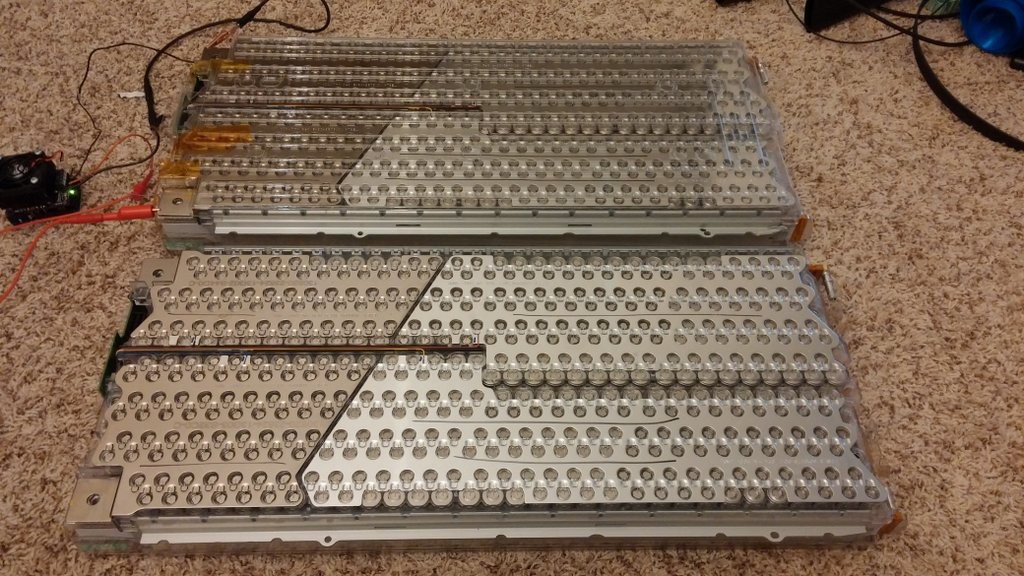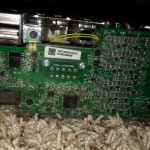I thought I’d share my crude notes on a very interesting talk about energy storage from Tesla CTO JB Straubel. The slides are available as a PDF.
- JB Straubel Keynote
- CTO, Tesla
- Previously CTO & co-founder of Volcom, specializing in high-altitude electric aircraft platforms
- Board Member, Solar City
- Why is Tesla Deeply invovled in Energy Storage
- EV Battery History
- Status quo was led-acid in 1995
- Stagnant performance
- LiIon made possible Tesla and the rebirth of EVs
- 4x gravimetric energy density
- 6x volumentric energy density
- 2x cycle life
- Tesla was first to do Li-ion R&D for vehicles in 2003
- Status quo was led-acid in 1995
- Tesla Roadster 2008
- Sought to challenge internal combustion vehicles on more than just fuel economy
- ~2,500 sold
- Largest battery pack in a vehicle
- 50kWh +
- Optimism based on progress of LiIon cells
- ~2x improvement in energy storage capability of batteries in the decade between EV1 era and the Tesla Roadster
- 300Wh/litr to 600Wh/litre
- Accompanying weight reduction as well
- In talking to companies involved in 2005, they saw no reason for progress to plateau
- Ten years later, they expect progress to continue for the foreseeable future.
- 40% improvement between introduction of the Roadster and the Model S
- ~300 miles range
- 85kWh
- Smaller pack than the roadster
- See this trend continuing for the next 10-20 years
- Only 10-20% away from being able to compete broadly with the internal combustion engine.
- ~2x improvement in energy storage capability of batteries in the decade between EV1 era and the Tesla Roadster
- Long term goal is to sell millions of cars
- Energy storage is the biggest factor influencing cost, and therefore, volume.
- Current offerings
- Roadster
- Model S
- Main focus
- OEM
- Toyota RAV 4
- Mercedes-Benz
- BClass
- Model S Battery Pack
- Scale & Scope have enabled a cost point that is competitive in other markets outside cars
- Utilities
- Energy density is a key path to lower cost
- Automobiles
- Not intuitive
- Some automobile manufacturers have tried to cut energy to cut costs.
- 200Wh/Kg
- Benefits for stationary storage
- smaller footprint
- easier retrofit
- Automobiles
- Current costs and projections are on track
- Manufacturing volume is important too.
- Goal to build 500,000 Gen3 vehicles/year
- using capacity in existing Bay Area Plant
- Energy storage required to meet that goal is another story
- In 2013 ~34 GWh of lithium ion batteries were manufactured, but from ~21 GWh in 2010.
- Tesla’s projects to use 3-4GWh in 2014
- Approximately 10% of WW volume
- 500,000 Gen3 vehicles/year will require 10x current, or ~35GWh of batteries in 2020.
- Gigafactory sized to meet that demand
- Would still only supply 0.5% of WW new car market.
- Doubling WW capacity
- Reengineering supply chain with major opportunity for cost cutting
- 30% cost reduction by 2017 ramp-up
- Thinks that the market for non-automotive storage will grow even faster than the electric car market.
- Grid storage is slow to mature, but once you cross certain price thresholds, it becomes a commodity market that sells on cost savings
- Approach to cost reductions at the gigafactory
- Looking at everything, including the sourcing of the raw materials.
- Materials are a meaningful portion of the cost of cells
- Plan to use their purchasing power to use demand as leverage for sustainable practices throughout the supply chain (labor practices, energy, etc)
- Gigafactory
- 35GWh of cells
- 50GWh of packs
- 15GWh for stationary packs
- 10x of the California mandate
- 15GWh for stationary packs
- Goal to build 500,000 Gen3 vehicles/year
- EV Battery History
- Tesla and Stationary Storage
- ~2012 adapted vehicle pack architecture for residential energy storage packs
- 5kW/10kWh
- Originally targeted at people with solar and teslas
- Slow to scale
- ~1000 systems
- People who wanted to play with energy in their house
- Peak demand management
- “Islanding” to isolate their system from grid and allow operation in the event of a power outage
- Experiment with aggregation of systems
- Coordinated across households
- Business models are a challenge
- New experiment is a larger-scale system
- Module
- Based on model S pack architecture
- Different arrangement of modules
- Same cooling and management
- Two hour-rate pack.
- 200kW / 400 kWh+
- “Single skid” unit
- Roughly the size of a shipping pallet
- 800Kg
- Based on model S pack architecture
- Pilot deployment
- SuperCharger location
- Big enough to be worth the time
- Very peaky load
- Up to 250KWh peak demand from cars
- <100KW peak from meter
- SuperCharger location
- Thinks that utility side opportunities are significant
- Backup power
- Demand management
- Scale up of renewables
- This will be the major driver for storage!
- Major adjustments needed in rate structures/incentives
- es- I wonder where trends in peak generation costs vs storage costs cross
- Large Pilot (2013)
- “One of the bigger installations”
- Tesla’s Fremont plant
- 1MW / 5 modules
- Manages ~10% of peak demand
- 100 MW substation with 100kV tie.
- 1-2% of installed grid-attatched storage
- In the process of doubling capacity
- “One of the bigger installations”
- Module
- ~2012 adapted vehicle pack architecture for residential energy storage packs
- Thinks of Tesla is an energy innovation company, more than a car company.
- Cautionary note about building for economic sustainability, avoiding dependency on incentive programs
- Innovation needed in storage management technology and relationship to grid and generation
- “The stone age came to an end not for lack of stones, and the oil age will come to an end not for lack of oil”
- Thinks the economics of renewables are already compelling and now constrained by storage
- Q&A
- Can the world support the scale up from a primary resource point of view
- Li-ion are primarily graphite/carbon for anode, nickle for the cathode (for their chemistry). Steel for can, polymers for separators, organics for electrolytes
- Predictions of shortages of lithium aren’t well founded
- Thinks there is a bubble in lithium prices, but Li-ion costs aren’t the major contributor to lithium cell costs
- Have you thought about the policy changes needed to drive this change?
- They have been building relationships with CPUCs and utities and even state and fed regulators, but it isn’t a big focus.
- Tesla is an innovation company that focuses on creating products that drive the need for regulatory changes.
- Utilities are conservative. Automotive experience is demonstrating that this technology is ready for utility use.
- Recyclability of lithium ion batteries
- Recycling is being built into the Gigafactory. With enough volume there are great opportunities for materials reuse.
- Challenge now is that growth is so steep that the volume of cells coming back is so much lower than current production
- What is the commercial lifespan of Lithium Ion batteries?
- Lithium ion batteries for the next 5-10 years
- Not waiting for the next big thing…
- Lithium ion cells make business sense now, which is why they investing.
- Looking historically, improvements aren’t necessarily revolutionary.
- Often it is through incremental improvements to components of the system that can leverage a lot of existing infrastructure for building cells and packs
- Better cathodes
- Better electrolyte
- Better separators
- Thinks we can double energy densities with better anode and cathode materials over the next 10 years.
- Often it is through incremental improvements to components of the system that can leverage a lot of existing infrastructure for building cells and packs
- 18650 vs other formats
- Thinks people are hung up on form-factor for no good reason
- At the scale they are dealing in what matters is whats inside.
- What matters
- Cost of materials
- Thermal / Safety parameters
- Their conclusion is that relatively smaller form factor are a reasonable optimization tradeoff between safety, thermal and cost.
- Slightly larger than an 18650
- Cylindrical makes sense from a cost perspective
- Some applications will have different characteristics
- Large cells just move complexity inside the cell
- Deployment plan and pricing metrics for fixed storage
- Depends on market
- Residential
- Leased to customer, bundled with larger offering
- Mid-market commercial customers
- Many prefer to buy outright
- Others want Tesla to provide savings, take care of utility interconnect, etc
- Some people don’t want to arbitrage their energy
- He did it at his for a while. Got bored with it
- Thinks at the end of day, Tesla or a 3rd-party financing company will end up owning most of the packs and be responsible for management
- Utilities are another matter, given the scale and dollars involved.
- Residential
- Depends on market
- Have you developed a center to deal with dispatch of modules?
- They are building it.
- Failure rate and warranty for modules
- Quite reliable
- Automotive application is much harsher
- Maybe over-engineered for fixed application
- Warranty rates are great
- Degradation profile
- Similar to cars
- Optimized for 10 year life
- Avoid paying too much for a product that outlasts the product, or the pack.
- What are your perspectives on the power converter, are you building it yourself?
- System design and integration are their major focus, just as with automobiles.
- The power electronics for Tesla Model S is a very capable starting point for these fixed storage modules.
- Costs for the power electronics are dropping quickly, will see less than $0.10W very quickly.
- Can the world support the scale up from a primary resource point of view





